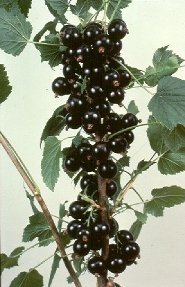Blackcurrants contain large amounts of ascorbic acid, with levels in commonly grown cultivars ranging from 150 - 200 mg/100 ml juice. Some breeding lines within the Institute programme contain over 350 mg/100 ml, and even higher levels are reported in wild accessions of R. nigrum var. sibiricum. Reports suggest that the ascorbic acid contained in blackcurrant fruit is more stable than most other sources, possibly due to the protective effects of anthocyanins and other flavonoids within the berries. The main period of ascorbic acid accumulation coincides with the berry expansion phase, soon after fertilization, and genotypic rankings of = content established in this early stage remained constant thereafter (Viola et al. 2000).

Blackcurrants grown for the fresh market
Blackcurrants are outstanding sources of antioxidants, both high ascorbate levels and also high concentrations of polyphenolic compounds such as flavonoids that are contained within the fruit (Lister 2002). Within the flavonoids are anthocyanins, which in blackcurrant are cyanidin-3-rutinoside, delphinidin-3-rutinoside, delphinidin-3-glucoside and cyanidin-3-glucoside. Relative proportions vary between genotypes, with older western European cultivars containing more cyanidin derivatives and Scandinavian cultivars a higher proportion of delphinidin derivatives. Many breeding programmes including the Institute programme have preferentially selected for a high delphinidin:cyanidin ratio (Brennan 1996) due to the higher stability of these compounds. Work is in progress to ascertain how ingested blackcurrant phenolics are actually taken up by the body and thereby play a role in proposed health benefits from berry consumption.
References
- Brennan RM (1996) Currants and gooseberries. In: Janick J & Moore JN (Eds.) Fruit Breeding, Vol. II: Vine and Small Fruits Crops. John Wiley and Sons, Inc. New York, pp. 191-295.
- Lister CE, Wilson, PE, Sutton KH & Morrison SC (2002) Understanding the health benefits of blackcurrants. Acta Horticulturae 585, 443-449.
- Viola R, Brennan RM, Davies HV & Sommerville L (2000) L-ascorbic acid accumulation in berries of Ribes nigrum L. Journal of Horticultural Science and Biotechnology 75, 409-412.
